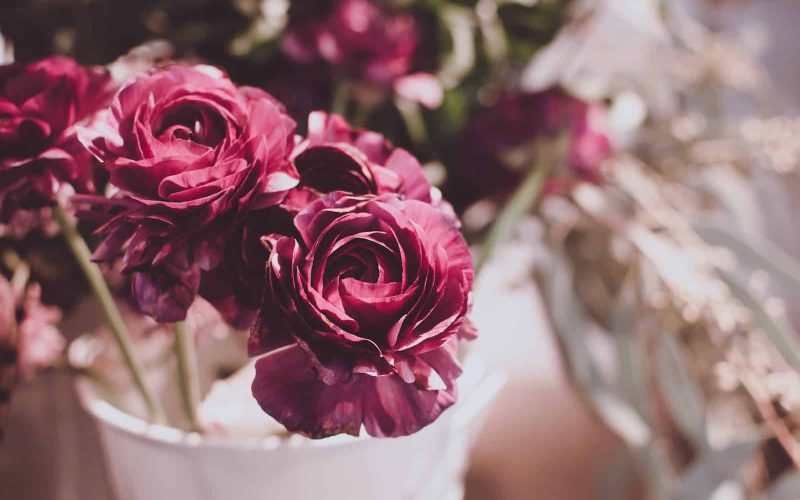Different types of floral designs use plant materials and flowers to adorn the home or public places to create an eye-catching and mesmerizing display.
This design is done to convey emotions using flowers, dried plant materials, ornaments, and leaves for decorative displays.
Floral design is both a decorative and creative art form, and there are various types of floral designs, which we will look at in this article.
Different types of Floral design require expertise in color, materials, shape, and size.
To a great extent, floral designers must understand how flowers and foliage can be used to achieve the right decoration for a particular occasion.
Not just any flowers are used in floral design, these flowers are in different shapes and sizes.
Flower arrangement in the different types of floral designs adds beauty, texture, and even fragrance to the environment since the human eyes naturally draw to stunning and mesmerizing designs.
The structure of a flower arrangement starts with the flower types, as the combination of different flower types makes the arrangement beautiful, especially in the flower bouquet types.
When selecting plant materials, color, shape, texture, size, space, and expressiveness must all be considered. All these are collectively known as all objects’ ‘design elements.’
The style or design for arranging the plant materials also matters. There are three general styles for arranging these materials; Line, Mass, and Line-Mass.
The shape of the container and the place where the arrangement will be used or the occasions of use are to be considered when selecting a floral design for your compound.
Different Types of Floral Designs Elements
1. The Color wheel
Three groups of colors make up the wheel; the primary, secondary, and tertiary colors.
Some flowers grow naturally in various colors, while others are selectively grown and hybridized.
Warm colors tend to advance to the eye, while cool colors tend to recede with lesser weights.
The color wheel can serve as a guide for a florist when designing.
It is important to note that flower colors need to harmonize with one another when designing, not only with themselves but with the container and even the background where the arrangement will be displayed.
2. Shape
Texture refers to the surface quality of the material and how it can be felt when touched. It can be fuzzy, smooth, rough, or glossy.
3. Size
This applies to visual or apparent size. It can be delicate, bold, or heavy.
Buds and tiny flowers are usually used at the top and edges of an arrangement, while large leaves are placed low.
4. Space
Spacing is as important as the flowers and leaves in the different types of floral designs element.
Some flowers or leaves are selected because of their spacing to make the arrangement catchy to the eye.
5. Expressiveness
This means the floral designs can convey emotions and feelings about the environment or the occasion.
We wouldn’t want to use flowers in burial ceremonies in an engagement party.
The selection of flowers and leaves expresses the occasion’s mood, idea, or sentiment.
For instance, red roses may say, “I love you,” while white roses can be elegant and formal.
Types of Flowers Used in Floral Designs
Filler, focus, line, and Greenery are the four main types of flowers used in floral design.
Each category performs a distinct function in accomplishing a design feature or philosophy.
1. Filler Flowers
Filler flowers are blooms with smaller sizes that complement the statement flowers. Some can stand alone as a bouquet, while others need to be paired.
Also called transitional forms, these flowers have small branching stems of smaller flowers, and they are used as stepping stones to fill in between the statement and line flowers.
Some common filler flowers include Baby’s Breath, Queen Anne’s lace, Alstroemeria, Status, Spray Dianthus, Freesia, Limonium, etc.
2. Focus Flowers
Focus flowers are known to be the ‘belles’ of the ball. These statement flowers create dominant focal areas that people immediately notice when looking at an arrangement.
Common examples of focus flowers include; Roses, Hydrangea, Calla lilies, Sunflowers, Alliums, Helianthus, or Peonies.
3. Line Flowers
Line flowers are tall, noticeable blooms that add a little bit of texture to various designs.
They are so-called because one stem consists of many blossoms in a row.
Also called spike flowers, they aim to add height to floral designs. Examples include; Bells of Ireland, Liatris, Gladiolus and Delphinium, etc.
4. Greenery
These flowers got their names from their color. Their leaves, stems, and buds are beautiful on their own.
Examples include Ivy, Eucalyptus, Myrtle, Fern, etc.
Different Types of Floral Design Arrangements
1. Line Arrangement
Successful line arrangements create a dynamic feeling of movement and life, encouraging creative experimentation and originality.
The linear quality of a few branches, flowers, or leaves is emphasized to produce a clean-cut, sparse look.
The line, shape, space, and expressiveness are of great concern in this arrangement.
2. Mass Arrangement
This type of arrangement requires numerous plant materials.
The colorful mass of the flowers and foliage must be noticed, giving the environment a complete look design.
The focal point, the center of interest, and the eye-catching element are usually developed.
Colors that harmonize with one another and the place of use should be used for proper enhancement, color blending, and a beautifully decorated environment.
3. Line-Mass Arrangement
A decision should be made on whether the line or the mass arrangement is used; to achieve a successful line-mass arrangement, both should not be equal in measurement, weight, or area.
This arrangement generally has a neat, uncluttered look with definite lines, plenty of open spaces, and well-defined mass.
This arrangement, if successful, results in a robust and unifying rhythm that catches the eye.
4. Vase Arrangements
There are different types of vases, which can be confusing as to which flowers can fit in for design.
The flower stems in a column vase should be kept long, as trimming should be done regularly.
Learning how to make a bouquet can be helpful when dealing with vases.
Hydrangeas are an excellent flower for the cube vase as their blooms sit right on the lip of the vase and express themselves beautifully.
The tall rounded vase goes well with line flowers such as the delphinium.
Different Types of Floral Designs
The list could go on and on regarding different types of floral designs.
Most of the time, the type of floral design depicts the arrangement you choose from, which will depend on what kind of event.
For example, from Garlands, commonly seen on the streets of India, to nosegays, mostly worn on a bride’s head, you may mainly utilize centerpieces if you’re hosting a gala.
However, a product launch with multiple product displays can benefit from branded long and low arrangements placed throughout the room.
No matter what event you may be coordinating, a specific design type is meant for you.
The following are the different floral designs used in decoration:
1. Wreaths
Wreaths are assortments of flowers, leaves, and fruits that are constricted to form rings.
These are typically used as household ornaments, most commonly as Christmas decorations.
2. Nosegay
The 15th century Middle English speakers joined nose with gay (which, at that time, meant ‘ornament’).
Interestingly, this nosegay is a fragrant bouquet worn around the head or bodice in Medieval times to mask unpleasant odors.
Still, it is commonly carried by brides today in wedding ceremonies. This bouquet traditionally contains flowers of only one type or color.
Flowers that look well when gathered in a tight cluster should be chosen for a nosegay bouquet.
3. Garlands
These circular or spiral arrangements of intertwined flowers or leaves are commonly used to decorate individuals, roads, houses, palaces, and cities.
These flowers are commonly seen among the people of India, symbolizing their cultural heritage.
It is believed, in India, that these flowers symbolize happiness, enthusiasm, excitement, aspiration, zeal, and beauty.
4. Boutonniere
Boutonniere is derived from the French word ‘buttonhole flower.’
Men often wear this floral decoration to accessorize their suits and tuxedo during formal events like weddings and dinner parties.
Hearty flowers that can hold up without water are best for boutonnieres.
5. Corsage
The corsage is an arrangement of flowers women wear as a fashion accessory at formal events like proms, housewarmings, and weddings.
This is one of the different floral designs; depending on the display, it can be made with any flower, often attached to a ribbon or band worn on the wrist.
6. Bouquet
This collection of flowers is arranged attractively and given as a present or carried on formal occasions.
It is important to note that bouquets can be styled in different beautiful ways to create unique designs.
These bouquets include round, cascade, presentation, contemporary, hand-tied, garden style, pomander, etc.
7. Pot au Fleur
This is an assemblage of two or more growing plants in a container in combination with an arrangement of cut flowers.
8. The Hedgerow Design
This is an interpretation of an herbaceous garden border or hedge. Dried materials and decorative banding are often used around the entire form to control the farm.
9. Mille de Fleur
Having its interpretation as ‘One Thousand Flowers,’ this design has its inspiration in arts as far back as the 15th and 16th centuries.
Many multi-colored blossoms without a single variety or hue dominance are featured.
10. Formal Linear
This design combines well-organized materials in groups emphasizing bold forms and clean lines.
The primary element in this design is the line, and negative space accentuates the individual flowers and leaves.
11. Della Robbia
This classic style of the different types of floral designs is characterized by the dominant use of fruits in wreaths, swag, and garland designs.
The style is named after Luco della Robbia, who created glazed terra-cotta reliefs of garlands of fruits and flowers.
12. Biedermeier Style
A Biedermeier-styled floral design is generally round or conical in shape with concentric patterning using circles or spirals.
The design is without negative space, with emphasis on the face of the flowers. The colors used in this design typically range from bright hues to wood tones.
Conclusion
The art of decorating and arranging different patterns of flowers to give off an expression that conveys feelings and emotions requires a basic knowledge of flowers.
Arranging your flowers to create something unique and beautiful can be a creative, fun, and mindful activity.
A floral design needs to have a range of different forms that harmonize with each other; this harmony creates a pleasing finished design that appears catchy to the eyes.
Whether on special occasions like birthdays, Mother’ day, or Valentine’s Day, or seeking an apology from a loved one, giving flowers as gifts has been a great way of expressing feelings and connecting with emotions.
Flower arrangements enhance the atmosphere of a room, be it a restaurant, a wedding, or any special occasion, and this is where the different types of floral designs come into play.
Figuring out the different shapes, sizes, and arrangements of the flowers, the container, and the environment will give the florist an edge in creating a fantastic piece of art with these flowers.
Choosing the right style is also essential to creating the right mood for the event.
There is a flower for every occasion, all you need is a creative mind and the tools to create the designs, and you are good to go!








